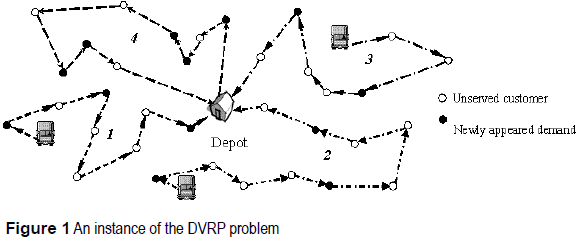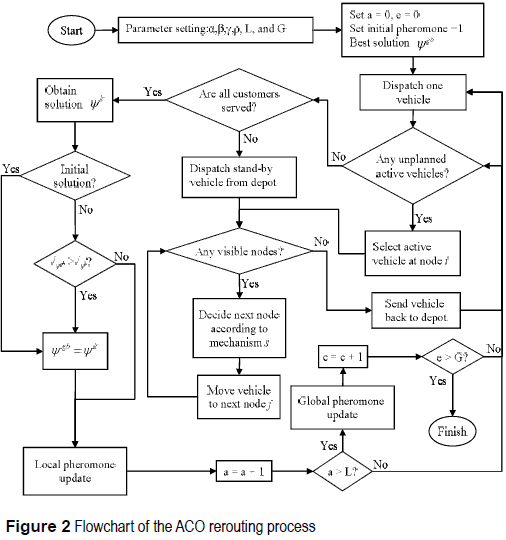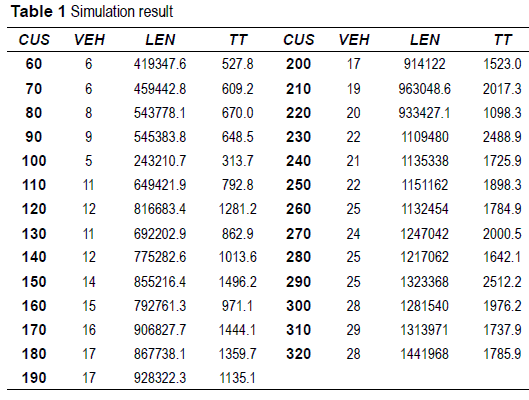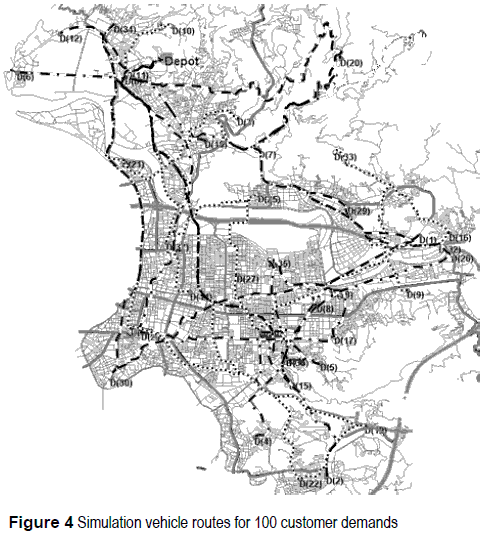Services on Demand
Journal
Article
Indicators
-
 Cited by SciELO
Cited by SciELO -
 Access statistics
Access statistics
Related links
-
 Cited by Google
Cited by Google -
 Similars in
SciELO
Similars in
SciELO -
 Similars in Google
Similars in Google
Share
Revista Facultad de Ingeniería Universidad de Antioquia
Print version ISSN 0120-6230
Rev.fac.ing.univ. Antioquia no.64 Medellín July/Sept. 2012
ARTÍCULO ORIGINAL
A model for solving the dynamic vehicle dispatching problem with customer uncertainty and time dependent link travel time
Un modelo para resolver el problema dinámico de despacho de vehículos con incertidumbre de clientes y con tiempos de viaje en arcos
Shan-Huen Huang1, Carola Alejandra Blazquez*2
1Department of Logistics Management, National Kaohsiung First University of Science and Technology (NKFUST), No. 1, University Rd. Yan-Chao Kaohsiung 82445, Taiwan.
2Departamento Ciencias de la Ingeniería. Universidad Andres Bello, Sazie 2315, Piso 2, Santiago. Chile.
*Autor de correspondencia: teléfono: + 56 + 2 + 661 8644. fax: + 56 + 2 + 770 3076, correo electrónico: cblazquez@unab.cl (C Blasquez)
(Recibido el 11 de julio de 2011. Aceptado el 20 de agosto de 2012)
Abstract
In a real world case scenario, customer demands are requested at any time of the day requiring services that are not known in advance such as delivery or repairing equipment. This is called Dynamic Vehicle Routing (DVR) with customer uncertainty environment. The link travel time for the roadway network varies with time as traffic fluctuates adding an additional component to the dynamic environment. This paper presents a model for solving the DVR problem while combining these two dynamic aspects (customer uncertainty and link travel time). The proposed model employs Greedy, Insertion, and Ant Colony Optimization algorithms. The Greedy algorithm is utilized for constructing new routes with existing customers, and the remaining two algorithms are employed for rerouting as new customer demands appear. A real world application is presented to simulate vehicle routing in a dynamic environment for the city of Taipei, Taiwan. The simulation shows that the model can successfully plan vehicle routes to satisfy all customer demands and help managers in the decision making process.
Keywords: Heuristics, dynamic vehicle routing; customer uncertainty, vehicle routing problem
Resumen
En un escenario real, los pedidos de los clientes son solicitados a cualquier hora del día requiriendo servicios que no han sido planificados con antelación tales como los despachos o la reparación de equipos. Esto es llamado ruteo dinámico de vehículos (RDV) considerando un ambiente con incertidumbre de clientes. El tiempo de viaje en una red vial varía con el tiempo a medida que el tráfico vehicular fluctúa agregando una componente adicional al ambiente dinámico. Este artículo propone un modelo para resolver el problema RDV combinando estos dos aspectos dinámicos. El modelo propuesto utiliza los algoritmos Greedy, Inserción y optimización basada en colonias de hormigas. El algoritmo Greedy es utilizado para construir nuevas rutas con los clientes existentes y los otros dos algoritmos son usados para rutear vehículos a medida que surjan nuevos clientes con sus respectivos pedidos. Además, se presenta una aplicación real para simular el ruteo vehicular en un ambiente dinámico para la ciudad de Taipei, Taiwán. Esta simulación muestra que el modelo es capaz de planificar exitosamente las rutas vehiculares satisfaciendo los pedidos de los clientes y de ayudar los gerentes en el proceso de toma de decisiones.
Palabras clave: Heurísticas, ruteo dinámico de vehículos, incertidumbre de clientes, problema de ruteo de vehículos
Introduction
The Vehicle Routing Problem (VRP) has been widely studied because of its application in logistic and supply chain management areas [1–6]. Generally, a VRP consists of planning routes for vehicles to serve a set of given demands. In many real world cases, customers request service when vehicles have already started their planned route. Successive requests compel service providers to adjust their dispatching plan several times a day to serve new customers in the same day. Since these customers are not predetermined, this type of dispatching plan yields a Dynamic Vehicle Routing Problem (DVRP) with customer uncertainty [7, 8]. In the literature, uncertainty situations include ambiguity in the amount of customer demand, vagueness in the presence of customers, or both [9]. The uncertainty in the amount of demand indicates that the demand of each customer is known only when the vehicle visits the customer such as in the garbage collection problem. The uncertainty in the presence of customers denotes that customer appearances are unknown in advance such as emergency calls. Many researchers have modeled the uncertainty problem by assuming demands or customer presence as a probabilistic function [2, 10, 11], which is denoted as a stochastic VRP (SVRP). To analyze the DVRP in a stochastic perspective is sometimes inappropriate when customers appear randomly anywhere on the network. Thus, other researchers have solved the DVRP with customer uncertainty by designing the routing procedure instead of assuming a stochastic behavior for uncertainty situations. For example, Khouadjia and colleagues [8] solved the DVRP using a population based (Particle swarm optimization) and a trajectory based (Variable neighborhood search) metaheuristic. Another study presented in [12] proposed an advanced particle swarm optimization algorithm to solve the VRP with uncertain demands and unknown distributions. Coslovich and colleagues [13] tackled the dial a ride problem with time windows and took the unexpected customers into account. Du and colleagues [14] analyzed the DVRP with customer uncertainty in the business to consumer electronic commerce environment. Yet another study addressed the VPR problem with uncertain demands using Neuro Dynamic Programming (NDP) yielding approximate solutions [11]. The author analyzed two NDP algorithms (optimistic approximate policy iteration and rollout policy), and concluded that the latter generates higher quality solutions.
In addition to customer uncertainty, other studies consider the time dependent link travel time [6, 7, 15, 16, 17]. Overall, models assume constant travel time on a link throughout the day or exploit simple procedures to adjust them. Unfortunately, these assumptions are weak approximations of real world conditions that include daily traffic congestions. Travel times in urban areas fluctuate due to more subtle variations resulting from various factors such as accidents, traffic conditions, and weather conditions causing late arrivals to customers and additional associated costs. Therefore, the travel time of a link varies depending on the time the vehicle entered a link on a roadway network. This property affects the VRP significantly while the time window constraints are taken into account.
Scarce studies have been published in the literature that combines customer uncertainty and time dependent link travel time [18, 19]. This research presents a model for solving the DVRP with heuristic algorithms while considering these two dynamic aspects in unison.
The remainder of the paper is organized as follows. The next section provides the problem statement description. Subsequently, the heuristics algorithms are proposed to solve the problem. Results of applying the models onto a simulated case are presented. Finally, conclusions and future work are discussed.
Problem statement
Customers place requests for pickup or delivery services through PC, PDA, Notebook, or Smartphones via Internet. These demand information are uploaded to the center information system of the service provider for further processing. A routing plan is achieved based on this information according to the embedded routing strategies of the center system. After a dispatching plan has been developed, new routes are sent out to the onduty drivers and they adjust their routes accordingly. For taking the uncertain demands into account while planning vehicle routes, the problem is divided into two stages: static and dynamic. The static part of the problem consists of handling customer requests that are known in advance. This is equivalent to the conventional VRP, where vehicles are dispatched from the depot, customers are served following a preplanned route, and eventually vehicles return to the depot without violating time windows and vehicle capacity constraints. The dynamic part of the problem consists of rerouting vehicles as new customer demands appear.
Figure 1 illustrates an example of the DVRP. The hollow circles indicate customers that are in the routing plan, but have not been served yet. The filled circles represent the newly appeared demands that have not been planned. The three vehicles are active vehicles, which are in the midst of their preplanned routes. Since these vehicles are not able to accommodate all unserved and newly appeared demands, the standby vehicle waiting at the depot will be dispatched to serve route 4.The start nodes of the routes for the active vehicles are either nodes at their current location or nodes to which they are heading. These nodes are represented as depots for the active vehicles, generating a multidepot problem. In addition, since active vehicles have already serviced some demands, the capacity of each active vehicle is less than the original capacity and differs to other vehicles. Therefore, heterogeneous vehicle capacities are considered in the problem resolution.
This research also considers the time dependent link travel time, where each link has an associated weight function indicating the travel time. The path from customer i to customer j with least travel time (i.e., shortest path) varies according to the departure time of the vehicle. The shortest path is computed between any pair of nodes assuming that time dependent link travel time network follows the First In First Out (FIFO) property [20], According to this property, if vehicle A enters a link earlier than vehicle B from the same initial location to the same destination traveling on the same link, then vehicle A will always arrive before vehicle B independent from the speed variations during the travel. In order to maintain the FIFO property, a speed time relationship is employed for calculating the travel time for each link instead of a travel time enter relationship. If a roadway network obeys the FIFO property, then a modified Dijkstra's algorithm is used to determine the shortest path with minimum travel time [21].
Heuristic algorithms
For the static part of the vehicle routing process, vehicle dispatching is planned in advance according to the amount of customer demands and time window constraints. This is a general VRP, in which all vehicles depart from the depot and return after completing their planned route. An easy to implement algorithm seems to be more suitable for the static stage since rerouting is expected in the near future. Hence, this paper employs the Greedy algorithm to plan each vehicle route during the static part of the process due to its simplicity. This algorithm constructs feasible vehicle routes by forcing vehicles to visit as many customers as possible. While vehicles are located at the depot or visiting a customer, the algorithm determines which visible customer is to be served subsequently. Unserved customers are candidates to be visited by a vehicle within its time window without violating capacity constraints. The algorithm selects the closest visible customer to the vehicle's current location.
If there are no visible customers, then the vehicle is dispatched back to the depot and the route is completed.
After a period of time, new customer demands are requested and wait for service. In order to satisfy these newly appeared demands, a vehicle rerouting process is required. Therefore, the dynamic part of the problem is generated and consists of the following steps:
• New demands are inserted into the existing routes using the Insertion algorithm. This algorithm computes a new route by inserting nodes that represent new customer demands into a preplanned route without violating constraints. During the insertion process, a vehicle's preplanned route is verified to determine if a time period exists between a pair of nodes to serve additional customers that are not located on the route. In this study, the Nearest Insertion (NI) method is employed to insert a demand node into the nearest route. Most vehicle routes are maintained and no new active vehicles are required when the number of new requests is relatively small for some time periods. This step is more economical when compared to rerouting all vehicles again.
• If the Insertion algorithm is not able to incorporate newly appeared demands into the existing routes without violating vehicle capacities and time window restrictions, then the entire process of rerouting of vehicles is triggered again. The Ant Colony Optimization (ACO) algorithm is utilized in this process to calculate the number of standby vehicles needed while dispatching all vehicles and minimizing the total travel time.
Ant colony optimization algorithm
Ant algorithms were proposed by Dorigo and colleagues [22, 23], which inspired from the observation of ant colonies' foraging behavior, as a multi-agent approach to difficult combinatorial optimization problems. These algorithms have been applied on several different problems such as quadratic assignment problem [24], allocation problem [25], travel salesman problem [22], and of course the VRP [6, 26-28]. This paper proposes a modified metaheuristic ACO algorithm, based on the algorithm presented in [29], to solve the problem considering both customer uncertainty and time dependent link travel times. The problem is modeled as a multidepot, multicapacity VRP, which is a well known NP hard problem.
Model
Let G = (V, E) be a network, where V is a set of nodes, E is a set of links, and E VxV. Each link has an associated weight indicating the travel time and is represented by a speed time function that describes a discrete or continuous relationship between travel speed and time. Therefore, the network is a time dependent link travel time network. A node is located at the depot, which corresponds to the start and end of the route. There are K vehicles situated at the depot ready to serve customers and with the assumption that all vehicles have the same capacity. These vehicles can only depart and return within a specific time period (Topen, Tclose), where Topen and Tclose denote the open and close of the depot, respectively. This is also known as the depot time window constraint, which describes the time period in which vehicles are allowed to serve customers. A number of customers C with C
VxV. Each link has an associated weight indicating the travel time and is represented by a speed time function that describes a discrete or continuous relationship between travel speed and time. Therefore, the network is a time dependent link travel time network. A node is located at the depot, which corresponds to the start and end of the route. There are K vehicles situated at the depot ready to serve customers and with the assumption that all vehicles have the same capacity. These vehicles can only depart and return within a specific time period (Topen, Tclose), where Topen and Tclose denote the open and close of the depot, respectively. This is also known as the depot time window constraint, which describes the time period in which vehicles are allowed to serve customers. A number of customers C with C  V are scattered throughout the network and each customer has a determined amount of demand. Similarly to the depot, each customer has a time window [Li, Ui] for service, where Li and Ui indicate the lower and upper bound of the time window for customer i, respectively. In order to simplify the problem, all customers are assumed to be located exactly at the nodes.
V are scattered throughout the network and each customer has a determined amount of demand. Similarly to the depot, each customer has a time window [Li, Ui] for service, where Li and Ui indicate the lower and upper bound of the time window for customer i, respectively. In order to simplify the problem, all customers are assumed to be located exactly at the nodes. Notation
AV: number of active vehicle
SV: number of standby vehicle
K: Set of vehicles
TTijk (t): travel time of link ij for vehicle k with entering time t
M: set of unserved demands
N: set of newly requested demands
O: depot
Di : demand of node i
Qk : remaining capacity of vehicle k
Aik : arrive time of node i for vehicle k
Li : lower bound of time window for node i
Ui : upper bound of time window for node i
PTi : processing time for node i
ST: starting time of the rerouting process
Tclose: close time of the depot
Xijk: = 1 if link ij is traveled by vehicle k, = 0 otherwise
Yik: = 1 if node i is visited by vehicle k, = 0 otherwise
i,j : customers or nodes
Mathematical formulation
The mathematical formulation is described as follows.
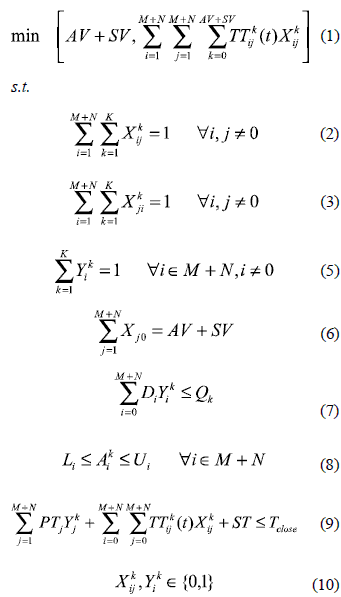
Equation (1) is the objective function of the mathematic formulation that consists of two objectives: minimizing the number of vehicles used and the total travel time in the rerouting process. Thus, the problem is modeled as a multiobjective programming. Equations (2) and (3) are the flow conservation constraints. Constraints (2)~(4) ensure that one node, except the depot, is visited once and only once by one vehicle. Equations (5) and (6) ensure that all vehicles return to the depot. Equation (7) is the capacity constraint. Since each active vehicle has different remaining capacities, Equation (7) ensures that the capacity of each vehicle will not be exceeded. Equations (8) and (9) are the time window constraints. Equation (8) ensures that each demand node is visited within its time window constraint and Equation (9) guarantees that all vehicles return to the depot before the close time of the depot. Equation (10) shows the decision variables constraints.
Solution
TheACO algorithm consists of a colony of artificial ants (vehicles) that assists in the determination of feasible solutions to difficult discrete optimization problems. These artificial ants are sent out from the nest (depot) to search for food and to establish trails mimicking real ants by depositing chemical traces (i.e., pheromones). Ants follow paths where pheromone concentrations are higher. The amount of pheromone that an ant deposits is reciprocal to the travel length, which indicates that shorter paths will contain higher amount of pheromone and, thus, a higher number of ants will select this path. In this study, pheromone is deposited according to the travel time instead of the travel length.
The procedure for generating the solution of the problem using the ACO algorithm is described as follows. A default amount of pheromone is associated with each link at the beginning of the algorithm. Ants choose links sequentially to travel from its current node to the next node without any restriction violations following the path finding scheme s, shown in Equation 11. If q is smaller than q0, then ants will select one of the visible nodes with the largest attraction Attij. Otherwise, ants will move according to the probability pij.

Where i is the current node that the ant located, j indicates other nodes, q0 is a preassigned fixed real number with values between 0 and 1, q is a random number, Ωi corresponds to the collection of visible, unvisited nodes from node i, and Attij denotes the attraction value of ant k from node i to node j given by Equation 12.

Where τij is the pheromone residual of the link between nodes i and j, ηij indicates the reciprocal of travel length between nodes i and j, and α, β, and γ are parameters for adjusting attraction values. The original equation did not take the travel time into account. However, Equation 12 has been multiplied by the reciprocal of the travel time for ant k to travel from node i to node j at time t ([TTijk (t)-1]γ), in order to eliminate unreasonable situations of high attractions when ant k has traveled for an excessive amount of time.
Equation 13 shows the probability pij computed as the ratio between the attraction from node i to node j and the summation of the attraction from node i to all visible nodes. If node j is not contained within the visible node set, then pij is 0.
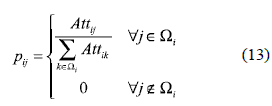
As ants construct routes, the amount of pheromone on each route is updated based on the quality of the solution obtained. The pheromone updating mechanism includes a local and a global pheromone updating mechanism. The local mechanism is computed immediately after an ant constructs a route (See Equation 14).

Where ρ denotes the evaporation rate with values between 0 and 1, and τij the pheromone residual on the path between nodes i and j. Let = , where Ψk represents the solution obtained by ant k and
, where Ψk represents the solution obtained by ant k and indicates the total travel time of the solution route constructed by ant k. Equation 15 represents the global pheromone updating mechanism, which is employed to obtain the amount of pheromone on each link after completing each iteration.
indicates the total travel time of the solution route constructed by ant k. Equation 15 represents the global pheromone updating mechanism, which is employed to obtain the amount of pheromone on each link after completing each iteration.

Where ρΔτij denotes the amount of pheromone added on the path between nodes i and j. Let  , where
, where  denotes the total travel time of the best solution obtained denoted as Ψgb. This means that the current best solution or optimum route is used as the baseline to improve the solution.
denotes the total travel time of the best solution obtained denoted as Ψgb. This means that the current best solution or optimum route is used as the baseline to improve the solution.
Figure 2 presents a flow chart with the ACO solution to the problem. A vehicle will yield a solution after completing a route and is denoted as one iteration. After all vehicles finish their routes, the global pheromone update scheme is triggered. This cycle is named an epoch. Parameters L and G are predefined constants that indicate the number of vehicles and the number of epochs, respectively. Therefore, there are a total of LxG iterations. The initial amount of pheromone on each link is equal to 1, and parameter values for α, β, γ, and ρ are previously set by the algorithm. Initially, variables ''a'' and ''e'' are set to zero, in order to control the number of iterations and epochs. First, the algorithm dispatches a vehicle and calculates the attraction from this vehicle to all other visible customer demand nodes. If there are no visible nodes, then the vehicle is sent back to the depot. Otherwise, the vehicle travels based on the probability pij. This process will be repeated until all active vehicles are dispatched back to the depot. If none of the active vehicles are capable of serving the customers, then standby vehicles are dispatched until all customers are served. An iteration is considered complete after standby vehicle routes are constructed using the local pheromone mechanism update. The global pheromone is updated when all vehicles finish their routes, and one epoch is completed. The best solution will be continuously updated after each iteration and is recorded in variable Ψgb. The algorithm will terminate when the number of epochs reaches the value of G
Computational simulation
The proposed procedure for solving the VRP with uncertain demands is assumed to be under the environment of time dependent link travel time in a roadway network. This problem is completely different than conventional VRP, and the authors are not aware of any benchmarks for comparison. Thus, a scenario was designed to assess the procedure of solving the problem with customer uncertainty on a real roadway network considering time dependent link travel time.
The heuristic algorithms proposed in this study were implemented through a GUI application to simulate the problem. This application employed a digital map with the roadway network of the city of Taipei, Taiwan, which contains 18653 links and 12241 nodes. In this simulation, it is assumed that the speed prediction for each link can be obtained from the Advanced Traveler Information System (ATIS) system. Three types of links are employed in this simulation and each has a speed time function to indicate their link weight, as shown in figure 3. Type A represents the light traffic conditions, type C represents the heavy traffic conditions, and type B denotes a traffic condition between types A and C.
The scenario of the computational simulation consists of one depot and 20 customers randomly located on the roadway network. The maximum capacity of each vehicle is equal to 200 units. The open and close times for the depot are set to 8 am and 4 pm, respectively. The initial demand and the time window constraint at each node are also randomly computed between 5 and 15, and between 8 and 4 pm, respectively. Subsequently, additional customer demands equal to 40, 50, 60,..., 300 are requested, in order to verify the response of the algorithm. A batch mode is employed to handle these demands in the simulation. Hence, vehicle rerouting is performed three times at 10 am, 12 pm, and 2 pm. Demands requested after 2 pm are not served within the same day and will be left for the next day. Table 1 presents the results of the simulation, where CUS is the number of customers; VEH is the number of vehicles; LEN is the total travel length in meters; and TT is the travel time in minutes. Overall, this table shows that the number of vehicles required to satisfy customer demands increases as demand batches appear. Note that in this simulation, the vehicles served all customers without violating any time window constraints. Figure 4 illustrates the simulation results with five vehicles routes serving 100 customers.
Conclusions
In light of the emerging mobile technologies and information systems, the seamless mobile and wireless connectivity between delivery vehicles and distribution facilities is paving the way for innovative approaches to real time vehicle routing and distribution management. Traditional solutions for VRP do not take the customer uncertainty and the real traffic situation into account and are not sufficient for many real world case scenarios. This paper presents a DVRP with customer demand uncertainty and time dependent link travel time. The procedure contains static and dynamic parts, which is modeled as a VRP with time windows, multidepot, and heterogeneous vehicle capacities. The static part of the problem was solved with the Greedy algorithm, and the dynamic part of the problem was solved by using Insertion algorithm and a modified ACO algorithm. A simulation application with real roadway network was generated to support managers in modifying existing routes or dispatching standby vehicles when unforeseen customer demands are requested.
In this research, real time traffic speed information was assumed to be known. If real time traffic speed information is obtained and sent to the vehicle dispatching system, then the online operation precision is improved. If a good ATIS is available, then special traffic conditions such as constructions, adverse weather conditions, incidents, and special events should be detected timely and dispatched to the system for advanced operations. In addition, the speed time relationship of each link should be collected by the ATIS as complete as possible to achieve an improved vehicle routing. Future work will compare the results of the proposed model to other heuristic algorithms such as tabu search, simulated annealing, or generic algorithms.
Acknowledgements
Financial support from Chilean National Fund for Scientific and Technological Development (FON- DECYT 1070386) is gratefully acknowledged.
References
1. D. Bertsimas, D. Simchi. ''A New Generation of Vehicle Routing Research: Robust Algorithms, Addressing Uncertainty''. Operations Research. Vol. 44. 1996. pp. 286-304. [ Links ]
2. R. Swihart, D. Papastavrou. ''A stochastic and dynamic model for the single-vehicle pick-up and delivery problem''. European Journal of Operational Research. Vol. 114. 1999. pp. 447-464. [ Links ]
3. G. Ghiani, G. Improta. ''An Efficient Transformation of the Generalized Vehicle Routing Problem''. European Journal of Operational Research. Vol. 122. 2000. pp. 11-17. [ Links ]
4. H. Lau, M. Sim, K. Teo. ''Vehicle Routing Problem with Time Windows and a Limited Number of Vehicles''. European Journal of Operational Research. Vol. 148. 2003. pp. 559-569. [ Links ]
5. G. Giaglis, I. Minis, A. Tatarakis, V. Zeimpekis. ''Minimizing Logistics Risk Through Real-Time Vehicle Routing and Mobile Technologies''. International Journal of Physical Distribution & Logistics Management. Vol. 34. 2004. pp.749-764. [ Links ]
6. A. Donati, R. Montemanni, N. Casagrande, A. Rizzoli, L. Gambardella. ''Time Dependent Vehicle Routing Problem with a Multi Ant Colony System''. European Journal of Operational Research. Vol. 185. 2008. pp. 1174-1191. [ Links ]
7. A. Haghani, S. Jung. ''A Dynamic Vehicle Routing Problem with Time-Dependent Travel Times''. Computers & Operations Research. Vol. 32. 2005. pp. 2959-2986. [ Links ]
8. M. Khouadjia, B. Sarasola, E. Alba, L. Jourdan, E. Talbi. ''A Comparative Study Between Dynamic Adapted PSO and VNS for the Vehicle Routing Problem with Dynamic Requests''. Applied Soft Computing. Vol. 12. 2012. pp. 1426-1439. [ Links ]
9. M. Gendreau, G. Laporte, R. Seguin. ''Stochastic Vehicle Routing''. European Journal of Operational Research. Vol. 88. 1996. pp. 3-12. [ Links ]
10. D. Papastavrou. ''A Stochastic and Dynamic Routing Policy Using Branching Processes with State Dependent Immigration''. European Journal of Operational Research. Vol. 95. 1996. pp. 167-177. [ Links ]
11. N. Secomandi. ''Comparing Neuro-Dynamic Programming Algorithms for the Vehicle Routing Problem with Stochastic Demands''. Computers & Operations Research. Vol. 27. 2000. pp. 1201-1225. [ Links ]
12. B. Moghaddam, R. Ruiz, S. Sadjadi. ''Vehicle Routing Problem with Uncertain Demands: An Advanced Particle Swarm Algorithm''. Computers & Industrial Engineering. Vol. 62. 2012. pp. 306-317. [ Links ]
13. L. Coslovich, R. Pesenti, W. Ukovich. ''A Two-Phase Insertion Technique of Unexpected Customers for a Dynamic Dial-A-Ride Problem''. European Journal of Operational Research. Vol. 175. 2006. pp. 1605-1615. [ Links ]
14. T. Du, E. Li, D. Chou. ''Dynamic Vehicle Routing for Online B2C Delivery''. Omega. Vol 33. 2005. pp. 33–45. [ Links ]
15. B. Fleischmann, M. Gietz, S. Gnutzmann. ''Time- Varying Travel Times in Vehicle Routing''. Transportation Science. Vol. 38. 2004. pp. 160-173. [ Links ]
16. S. Ichoua, M. Gendreau, J. Potvin. ''Vehicle Dispatching with Time-Dependent Travel Times''. European Journal of Operational Research. Vol. 144. 2003. pp. 379-396. [ Links ]
17. A. Kok, E. Hans, J. Schutten. ''Vehicle Routing under Time-Dependent Travel Times: The Impact of Congestion Avoidance''. Computers & Operations Research. Vol. 39. 2012. pp. 910-918. [ Links ]
18. J. Potvin, Y. Xu, I. Benyahia. ''Vehicle Routing and Scheduling with Dynamic Travel Times''. Computers & Operations Research. Vol. 33. 2006. pp. 1129-1137. [ Links ]
19. S. Lorini, J. Potvin, N. Zufferey. ''Online Vehicle Routing and Scheduling with Dynamic Travel Times''. Computers & Operations Research. Vol. 38. 2011. pp. 1086-1090. [ Links ]
20. B. Dean. Shortest Paths in FIFO Time-Dependent Networks: Theory and Algorithms. Technical report. 1999. Available in: http://www.cs.clemson.edu/~bcdean/paper23.html. Last access: June 13, 2011. [ Links ]
21. K. Sung, M. Bell, M. Seong, S. Park. ''Shortest Paths in a Network with Time-Dependent Flow Speeds''. European Journal of Operational Research. Vol. 121. 2000. pp. 32-39. [ Links ]
22. M. Dorigo, M. Gambardella. ''Ant Colonies for the Traveling Salesman Problem''. BioSystems. Vol. 43. 1997. pp. 73-81. [ Links ]
23. M. Dorigo, E. Bonabcau, G. Theraulaz. ''Ant Algorithms and Stigmergy''. Future Generation Computer System. Vol. 16. 2000. pp. 851-871. [ Links ]
24. M. Solimanpur, P. Vrat, R. Shankar. ''Ant Colony Optimization Algorithm to the Inter-Cell Layout Problem in Cellular Manufacturing''. European Journal of Operational Research. Vol. 157. 2004. pp. 592-606. [ Links ]
25. Y. Liang, E. Smith. ''An Ant Colony Optimization Algorithm for the Redundancy Allocation Problem (RAP)''. IEEE Transactions on reliability. Vol. 53. 2004. pp. 417-423. [ Links ]
26. K. Doerner, M. Gronalt, R. Hartl, M. Reimann, C. Strauss, M. Stummer. Savings Ants for the Vehicle Routing Problem. S. Cagnoni, J. Gottlieb, E. Hart, M. Middendorf, G. R. Raidl (editors). Application of Evolutionary Computing. Springer LNCS 2279. Berlin/Heidelberg, Germany. 2002. pp. 11-20. [ Links ]
27. E. Bell, R. McMullen. ''Ant Colony Optimization Techniques for the Vehicle Routing Problem''. Advanced Engineering Informatics. Vol. 18. 2004. pp. 41-48. [ Links ]
28. C. Chen, C. Ting, P. Chang. ''Applying a Hybrid Ant Colony System to the Vehicle Routing Problem''. Computational Science and Its Applications- ICCSA. Vol. 3483. 2005. pp. 417-426. [ Links ]
29. S. Huang, P. Lin. ''A Modified Ant Colony Optimization Algorithm for Multi-Item Inventory Routing Problems with Demand Uncertainty''. Transportation Research PartE. Vol. 46. 2010. pp. 598-611. [ Links ]













